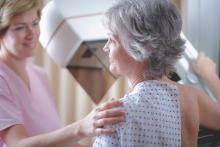Women with dense breasts may benefit from additional screening at the time of digital mammography, but the messages notifying these women of potential risks and benefits of more screening are often poorly written and understood, according to a pair of studies published online in JAMA on April 26.
Adding tomosynthesis to screening digital mammography significantly increased cancer detection rates in women with dense and nondense breasts, based on data from a retrospective study of 452,320 examinations.
Dense breast tissue may be an independent risk factor for breast cancer, but the impact of additional treatment modalities on women with dense breasts has not been well studied, wrote Dr. Elizabeth A. Rafferty of L&M Radiology in West Acton, Mass., and associates. Dr. Rafferty conducted the study with colleagues while affiliated with Massachusetts General Hospital in Boston (JAMA 2016 Apr 26. doi: 10.1001/jama.2016.1708).
The researchers reviewed data from an earlier multicenter study involving 13 U.S. institutions, with data reported for 12 months that included 278,906 digital mammographies and 173,414 digital mammographies plus tomosynthesis. A total of 2,157 cancers were diagnosed. Cancer detection rates increased in both groups with the addition of tomosynthesis: Invasive cancer detection increased from 3.0 to 4.0 per 1,000 screens in nondense breasts and from 2.9 to 4.2 per 1,000 screens in dense breasts.
In addition, recall rates decreased from 90 to 79 per 1,000 screens in nondense breasts and from 127 to 109 per 1,000 screens in dense breasts.
Although the study was limited by its retrospective design, the results suggest that the “combined gains were largest for women with heterogeneously dense breasts, potentially addressing limitations in cancer detection seen with digital mammography alone in this group, but were not significant in women with extremely dense breasts,” the researchers noted.
The researchers had no financial conflicts to disclose, and the study was supported by a research grant from Hologic.
Meanwhile, a separate study published in JAMA found that most messages sent to notify women of breast density are poorly understood.
Nancy R. Kressin, Ph.D., of Veterans Affairs Boston Healthcare System and Boston University and colleagues examined the dense breast notifications sent to women following screening mammography in 23 of the 24 states that required such notifications as of January 2016. They assessed the messages for content, readability, and understandability (JAMA 2016 Apr 26. doi: 10.1001/jama.2016.1712).
Although all the notifications reviewed mentioned masking bias (how dense breasts can mask cancer on mammography), the researchers found considerable variation in other content: 74% of notifications mentioned increased cancer risk and 65% mentioned the option of additional screening. Of the 15 states that require supplemental screening to be mentioned, six state notifications explained that the women might benefit from such screening and four state notifications mentioned specific screening modalities.
Only three states’ notifications were written at grade 8 reading level or below, although approximately 20% of the U.S. population reads at grade 5 level or below, the researchers noted. All states’ notifications scored between 11% and 33% on a measure of readability.
“Many [dense breast notifications] appropriately encourage discussions and shared decision making between patients and physicians,” the researchers noted. However, “efforts should focus on enhancing the understandability of [dense breast notifications] so that all women are clearly and accurately informed about their density status, its effect on their breast cancer risk, and the harms and benefits of supplemental screening,” they wrote.
Dr. Kressin reported receiving a Research Career Scientist award from the Department of Veterans Affairs, and coauthor Dr. Tracy Battaglia is the chair elect of the American Cancer Society of New England.


